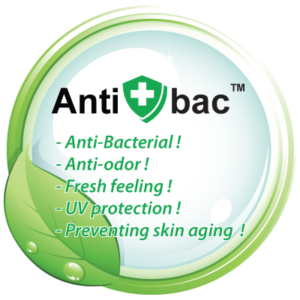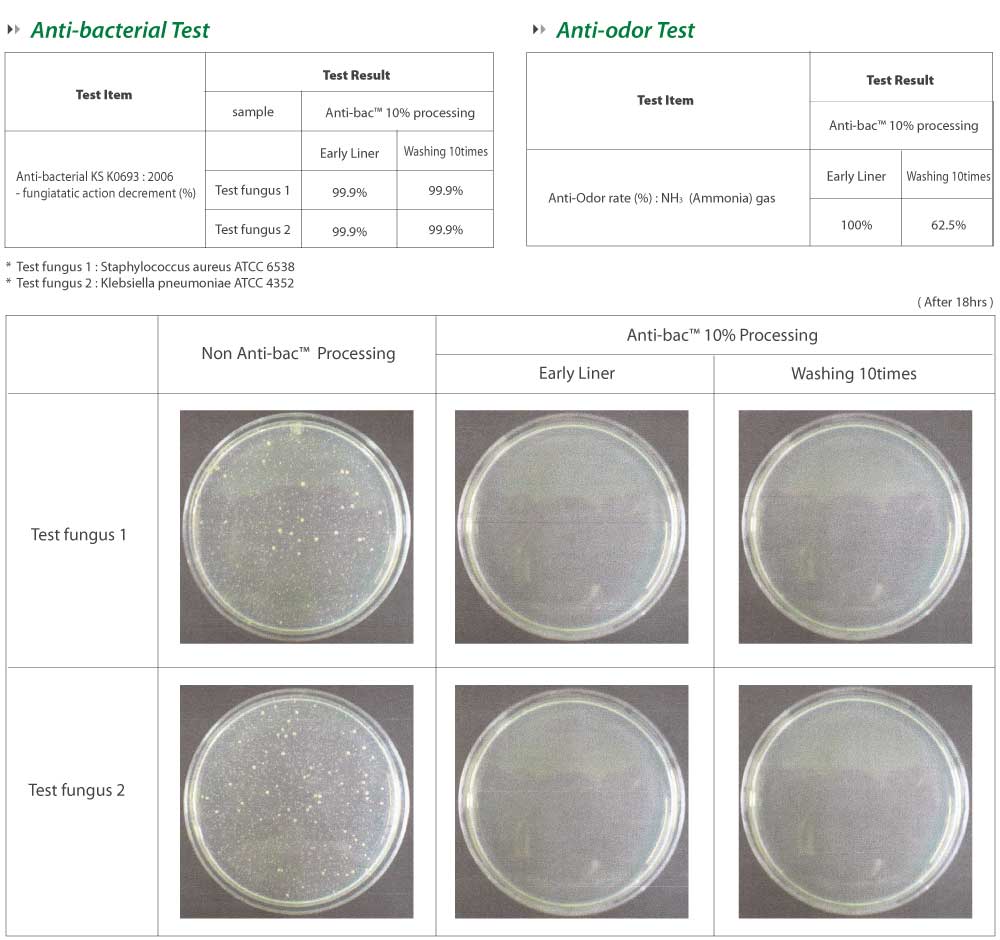About Anti-bac™
 The antibacterial technology developed by Kenima Co., Ltd. provides an additional level of protection for industrial workers by suppressing harmful bacteria (ex. Staphylococcus aureus ATCC 6538, Klebsiella ATCC 4352) and removing odor by applying a special antibacterial treatment to coated gloves. This technology maintains antibacterial and deodorizing properties even after washing the gloves more than 5 times.
The antibacterial technology developed by Kenima Co., Ltd. provides an additional level of protection for industrial workers by suppressing harmful bacteria (ex. Staphylococcus aureus ATCC 6538, Klebsiella ATCC 4352) and removing odor by applying a special antibacterial treatment to coated gloves. This technology maintains antibacterial and deodorizing properties even after washing the gloves more than 5 times.
Anti-bac™ is the first innovative challenge to attempt antibacterial protection in the field of industrial safety gloves, and is a technology that demonstrates the company’s ability to innovate to the world’s best.
Anti-bac™ Features: Antibacterial, deodorizing, refreshing, UV protection, antistatic, anti-aging

About HPPE
HPPE(High-strength polyethylene) is the strongest fiber in the world. (15 times stronger than steel and 40% stronger than aramid when comparing steel and aramid of the same weight) HPPE fibers are thinner, more elastic, and more protective than traditional fibers such as leather and cotton. It also has excellent durability and better abrasion and cut strength than man-made fibers. Another term for HPPE(High performance polyethylene) is ultra-high molecular weight polyethylene (UHMWPE=Ultra-high-molecular-weight polyethylene).
About Nylon
Nylon is the oldest synthetic fiber. It was invented in 1938 by Carothers of DuPont, USA, and belongs to the polyamide family. Nylon is the general name given to polyamide synthetic fibers, but the name varies by country or manufacturer. It is thinner than spider web, resistant to friction, and has much higher tensile strength than other fibers. It is also lighter than wool, its strength does not change even when wet, and it has elasticity and heat retention. It is not damaged by insects, so it is widely used from clothing to industrial purposes. With the advent of heat-treated, twisted wool nylon, crepe nylon, and other various processing methods, it has gained elasticity and texture like wool, and it also has absorbency, so its uses are continuously expanding.
About Polyester
Polyester fiber is a high-molecular synthetic fiber that was industrialized in the UK in 1950 and is currently used to the extent that it accounts for half of the synthetic fiber production. The most widely used one is polyethylene terephthalate, also known as PET fiber. Polyester fiber has the second best elasticity after nylon and shows the same strength when wet or dry. It has good elasticity, so it recovers quickly, and it has excellent shape stability, so it does not wrinkle easily and maintains its original shape. It has the lowest absorbency and processing moisture content of all fibers, so it can be used right away without washing or ironing. However, the amount of static electricity and fluff is higher than other chemical fibers. However, it has good blending properties with other fibers, so it can be blended well with other fibers in addition to 100% polyester products, and it also has excellent spinnability.
About PU (Polyurethane)
Polyurethane is a unique material that has the elasticity of rubber and the durability of metal, and is a general term for polymer compounds that have urethane bonds -OCONH- in their molecules.
Polyurethane has stronger frictional strength and tension than rubber and can withstand higher loads of objects, and is more impact-resistant, less abrasive, and more elastic than plastic. It is replacing metal in sleeve bearings, gears, rollers, and various other parts because it is being developed to be light, quiet, and less abrasive. It also has excellent resistance to oil, solvents, grease, fat, and gasoline, and has better resistance to loads of objects than other common rubbers. It has excellent resistance to oxygen, ozone, sunlight, and general weather, and is elastic and durable. Hard urethane is used as gears where it can reduce product noise, and soft urethane is replacing rubber with its excellent noise and vibration damping effect. Because it has excellent electrical insulation properties and is resistant to heat and cold, it is often used as a pad for drive belts, dividers, and machines, as well as for metal plate covers and cable work parts.
About NBR (Nitrile Butadiene Rubber)
NBR (Nitrile Butadiene Rubber) is a copolymer of butadiene and acrylonitrile, and is a representative oil-resistant synthetic rubber, and is made by emulsion polymerization like SBR. Although it is a butadiene-based synthetic rubber, NBR is a special synthetic rubber due to its characteristics, and there are many varieties that cannot be compared with SBR. The essential characteristic of NBR is its oil resistance, and compared to NR and SBR, its heat resistance is slightly better and its flexural crack resistance is slightly inferior. In addition, since it has a nitrile group in the molecule, its electrical properties are not so good.
About PVC
PVC is a type of thermoplastic plastic, also known as polyvinyl chloride resin.
Its characteristics are that it is difficult to bond during processing, and it is hard and brittle when used alone, but it becomes elastic by adding a plasticizer. It also has low heat resistance, is resistant to all acids/alkali, and is waterproof, so it is processed into a wide range of products such as pipes, films, sheets, molded products, and caps.
